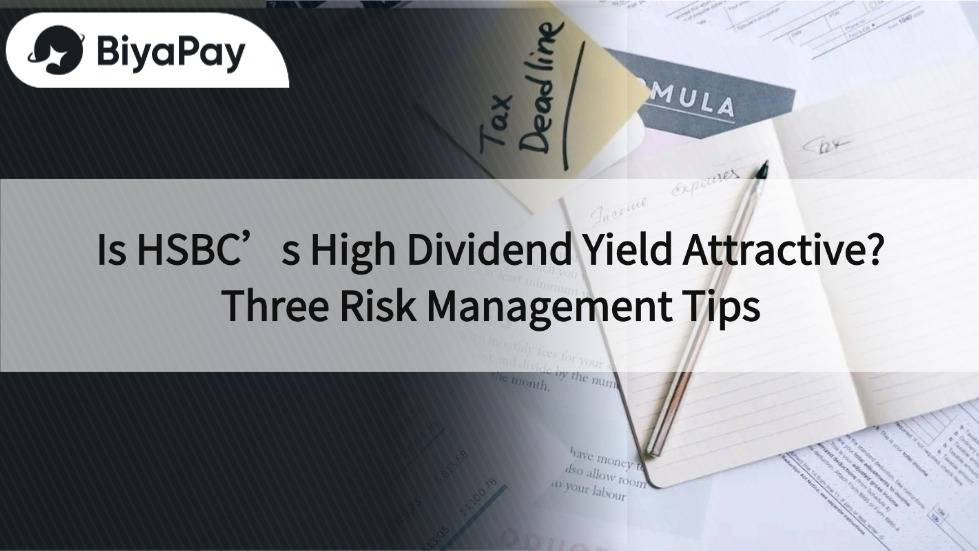- EasyCard
- Trade
- Help
- Announcement
- Academy
- SWIFT Code
- Iban Number
- Referral
- Customer Service
- Blog
- Creator
Is HSBC’s High Dividend Yield Attractive? Three Risk Management Tips

Image Source: pexels
You might find HSBC’s share price attractive because it has consistently paid stable dividends with a yield higher than many Hong Kong banks. However, you should note that business growth is starting to slow, and policy changes and market volatility can affect returns. Before investing, you should consider three questions:
- Can the dividend payments continue?
- Will the global economic environment worsen?
- How high is your own risk tolerance?
Key Points
- Diversifying investments can effectively reduce single-stock risk; it’s recommended to hold multiple stocks and diverse assets to enhance portfolio stability.
- Analyzing HSBC’s fundamentals, including dividend policy, interest rate changes, and financial metrics, helps understand share price fluctuations and the company’s competitiveness.
- Staggered buying and selling strategies can reduce risks from market volatility, helping control costs and lock in profits.
- Setting stop-loss points and allocating funds reasonably can minimize losses in time, avoiding emotional impacts on investment decisions.
- Continuously monitoring policy and market changes and flexibly adjusting investment strategies can improve risk management effectiveness and long-term returns.
Diversification

Image Source: pexels
When investing in HSBC’s share price, never put all your funds into a single stock. Even though HSBC is a blue-chip stock, it is still affected by external factors like international trade and policy changes. Single-stock risk is high, and diversification can help you reduce the chance of losses.
Multi-Asset Allocation
You can consider allocating funds to different assets, such as stocks, bonds, real estate funds, or commodities. According to Bloomberg’s data over the past 11.5 years, the annualized return of global multi-asset portfolios is no lower than traditional stock-bond balanced allocations, but with lower volatility. This means multi-asset allocation can effectively reduce risks from market fluctuations. Fidelity’s multi-asset strategy also proves that through rotation among different asset classes, volatility is close to that of investment-grade bonds, with stable performance. You can use these strategies to make your portfolio more resilient.
Tip: Research shows that holding about 10 to 20 different stocks can eliminate 95% of diversifiable risk. Over-diversifying in similar asset types, however, may dilute returns, a phenomenon called “Diworsification”.
Staggered Buying and Selling
You don’t have to buy or sell HSBC shares all at once. Staggered buying (dollar-cost averaging) and staggered selling can help you spread the risk of market timing. Here’s a comparison of different strategies:
| Investment Strategy | Holding Period | Average Cumulative Return |
|---|---|---|
| Lump-Sum Investment | 3 Years | 41% |
| Staggered Buying | 3 Years | 26% |
| Lump-Sum Investment | 5 Years | 77% |
| Staggered Buying | 5 Years | 52% |
| Lump-Sum Investment | 10 Years | 218% |
| Staggered Buying | 10 Years | 153% |
You can see that lump-sum investments yield higher long-term returns, but staggered buying can effectively lower average costs and psychological pressure during short-term market crashes or volatility. If you have a stable income and lower risk tolerance, staggered buying is more suitable for you. You can also sell in batches based on market conditions, gradually locking in profits and reducing the risk of selling at a single point.
Reminder: While HSBC’s share price is attractive, market and policy changes are hard to predict. Diversification and staggered operations can help you better manage risks.
HSBC Share Price and Fundamentals

Image Source: pexels
Factors Driving Share Price Volatility
You will notice that HSBC’s share price often fluctuates. These fluctuations mainly come from several aspects. First, HSBC’s dividend policy directly affects market confidence. If the company announces an increase in dividends, investors are usually optimistic, and HSBC’s share price may rise. Conversely, a dividend cut can disappoint the market, potentially causing the share price to fall. Second, interest rate changes significantly impact the banking sector. When the U.S. Federal Reserve raises rates, HSBC’s interest income increases, boosting profits and driving up the share price. However, if rates fall, banks’ interest margins narrow, increasing profit pressure and potentially weighing on the share price. Finally, the global economic environment is crucial. Global economic instability, geopolitical risks, or regulatory policy changes can cause significant fluctuations in HSBC’s share price.
Financial and Valuation Metrics
When analyzing HSBC’s share price, you should pay attention to several key financial metrics. Tangible Book Value reflects the actual value of the company’s assets. The Price-to-Earnings Ratio (P/E Ratio) is used to assess whether the share price is reasonable. A high P/E ratio indicates that the market has high expectations for the company’s future growth. For profitability, you can refer to the Return on Tangible Equity (RoTE). This metric shows how efficiently the company uses shareholders’ capital. A consistently high RoTE compared to peers indicates strong management performance. You can also compare HSBC’s P/E ratio and return on assets with other Hong Kong banks to understand its competitiveness.
| Metric | Description |
|---|---|
| Tangible Book Value | Reflects the actual value of the company’s assets |
| P/E Ratio | Measures whether the share price is reasonable |
| RoTE | Assesses profitability and management performance |
ESG and Sustainability
You may be concerned about HSBC’s performance in Environmental, Social, and Governance (ESG) aspects. According to academic research in Taiwan’s electronics industry, higher ESG scores drive corporate operating performance, including share price returns and return on capital. The research indicates that good corporate governance has the greatest impact on long-term development. When a company performs well in ESG, investors trust its sustainable operating capabilities more, leading to increased capital inflows, which ultimately reflect in HSBC’s share price and operating performance. When considering long-term investments, you should pay more attention to HSBC’s ESG reports and related policies to gauge its future development potential.
Risk Control
Stop-Loss and Fund Management
When investing in HSBC’s share price, you should learn to set stop-loss points. A stop-loss can help you minimize losses when the market suddenly drops. For example, you can pre-set a price level at which you automatically sell if the share price falls below it. This prevents emotions from affecting your judgment. You should also allocate your investment funds wisely, avoiding putting all your money into a single investment. This preserves cash, allowing you to seize good opportunities when they arise.
According to market data, a 60/40 balanced portfolio takes an average of 24 months to recover losses after a market crash. If you systematically hold hedging instruments, such as bonds or structured products, you can effectively reduce drawdowns and enhance long-term financial stability. You should also learn to lock in profits. During market volatility, if you fail to lock in profits in time, gains may disappear within just 13 days. You can consider selling in batches to gradually realize profits.
| Risk Control Measure | Specific Data or Case | Effect Description |
|---|---|---|
| Systematic Holding of Hedging Instruments | A 60/40 balanced portfolio takes an average of 24 months to recover losses after a peak drawdown | Effectively reduces drawdown amplitude, enhancing long-term financial stability |
| Locking in Profits | If profits are not locked in time, market volatility may cause gains to disappear after just 13 days | Reduces the risk of profit loss due to sharp market fluctuations |
Tip: You can use diversified strategies and structured hedging tools, such as options, to reduce single-stock risk and capture more mean-reversion opportunities.
Monitoring Policy and Market Changes
You should regularly stay updated on policy and market developments. HSBC’s share price is influenced by international interest rates, regulatory policies, and geopolitical events. When the U.S. Federal Reserve adjusts rates, Hong Kong banks’ profit models change accordingly. You can periodically review your portfolio’s risk models. Different look-back periods affect the accuracy of risk assessments. For example, 2-year and 20-year look-back periods yield significantly different risk profiles for portfolios. You should flexibly adjust risk management strategies based on your investment goals and market conditions.
You can also refer to diversified strategies and structured hedging tools. These tools can help limit downside risks during significant market fluctuations, improving risk-adjusted returns. By continuously monitoring market changes and adjusting strategies in time, you can manage investment risks more effectively.
You may find HSBC’s high yield and stable image very attractive. However, you should carefully assess risks before investing. You can make good use of the following three tips:
- Diversify investments to reduce single-stock risk
- Analyze fundamentals to understand the factors behind HSBC’s share price
- Implement risk control by setting stop-loss points
It’s recommended to stay updated on market and company developments, flexibly adjust strategies, and make informed decisions based on your goals.
FAQ
Can HSBC’s High Dividend Yield Continue?
HSBC has a history of stable dividends, but the future depends on profits, regulatory requirements, and the global economy. You should regularly review company announcements and financial reports.
How Much Capital Is Needed to Invest in HSBC? Is There a Minimum Threshold?
You can buy one lot of HSBC shares with a small amount of capital. Based on June 2024 exchange rates, one lot costs approximately USD 600 to USD 700.
What Are the Main Factors Affecting HSBC’s Share Price?
HSBC’s share price is influenced by interest rates, policies, the global economy, and dividend policies. You should closely monitor changes in these factors.
What Advantages Does HSBC Have Compared to Other Hong Kong Banks?
HSBC operates globally, with a large scale and strong capital strength. You can compare its P/E ratio and return on assets to understand its competitiveness.
What Are the Risks of Investing in HSBC? How Can They Be Managed?
You face risks from market volatility, policy changes, and exchange rates. You can diversify investments, set stop-loss points, and regularly review your portfolio.
HSBC’s high dividend (7.2%) and stable payouts allure investors, but profit volatility and market risks demand careful management. BiyaPay empowers flexible investing, enabling US and Hong Kong stock investments without extra overseas accounts—start now at BiyaPay! With transfer fees as low as 0.5% and coverage across 190+ countries, it meets global funding needs. Real-time exchange rate queries enhance USD-HKD tracking, complementing economic calendar monitoring.
Its 5.48% annualized yield wealth product offers flexible withdrawals to navigate volatility. Regulated internationally, it ensures secure transactions. Visit BiyaPay today to optimize your investment strategy!
*This article is provided for general information purposes and does not constitute legal, tax or other professional advice from BiyaPay or its subsidiaries and its affiliates, and it is not intended as a substitute for obtaining advice from a financial advisor or any other professional.
We make no representations, warranties or warranties, express or implied, as to the accuracy, completeness or timeliness of the contents of this publication.




Contact Us
Company and Team
BiyaPay Products
Customer Services
is a broker-dealer registered with the U.S. Securities and Exchange Commission (SEC) (No.: 802-127417), member of the Financial Industry Regulatory Authority (FINRA) (CRD: 325027), member of the Securities Investor Protection Corporation (SIPC), and regulated by FINRA and SEC.
registered with the US Financial Crimes Enforcement Network (FinCEN), as a Money Services Business (MSB), registration number: 31000218637349, and regulated by FinCEN.
registered as Financial Service Provider (FSP number: FSP1007221) in New Zealand, and is a member of the Financial Dispute Resolution Scheme, a New Zealand independent dispute resolution service provider.




















